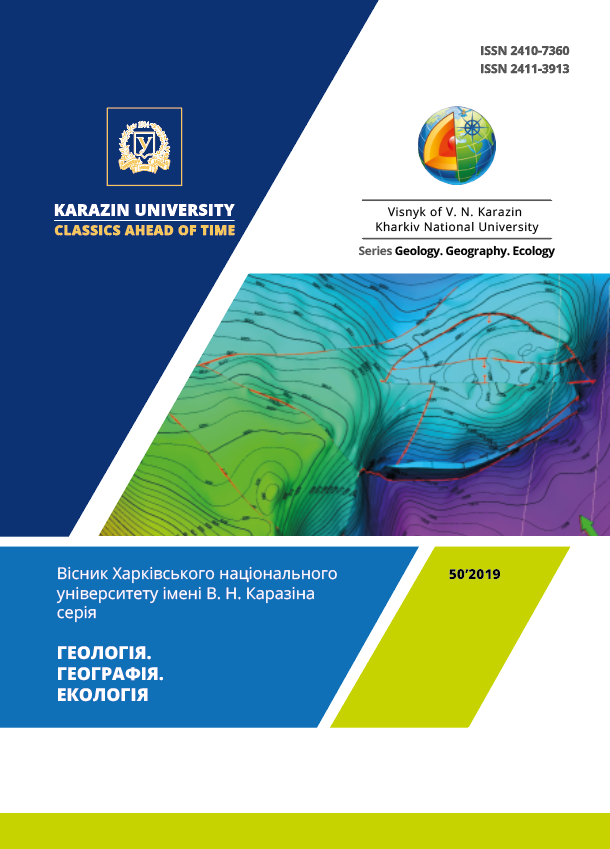The study of the periodicity of catastrophic spring floods on the territory of Ukraine
Abstract
Introduction. In the period of global and regional climate change in almost all the regions of our planet there is an increase in cases of extreme natural phenomena, which definitely include floods of various origin. Over the past decades, according to the Centre for Research on the Epidemiology of Disasters (CRED), in many countries of the world there has been a record high number of natural disasters which affected about 2.7 billion people, that is more than one third of the world's population.
The purpose of article is to analyze historical data and study the current state and trends in the frequency of catastrophic floods.
Methods. To estimate the trends in the chronological series of the maximum runoff of rivers the methods of statistical analysis and spatial generalization have been used.
Results. On the basis of literature sources and taking into account current data, frequency of flooding in the period from 900 to 2010 in the territory of Kyivan Rus and modern Ukraine has been estimated. Analyzing the results obtained, it can be noted that the largest number of floods was observed in the period from 1501 to 1600 years (11 cases), from 1601 to 1700 years (13 cases), and in the modern period from 1901 to 2000 (10 cases); 900-1000 and 1701-1800 years can be considered as the periods with the smallest number of cases. Since the beginning of the new millennium catastrophic and high floods have been observed in Europe almost every year. In order to estimate the repeatability of catastrophic floods at the rivers in Ukraine, the chronological series of the maximum runoff of spring water have been made up in accordance with the data of hydrological stations, which have the largest and preferably continuous periods of observations from their beginning until 2015 inclusive. The analysis has shown that in Ukraine the spring floods in 1932 and 1970 are classified as catastrophic. The analysis of trends in the chronological series of annual maxima in conditions of climate change showed their heterogeneity across the territory of Ukraine: on the left bank of the Dnieper and in the Siverskyi Donets basin there is a tendency towards earlier periods of snowmelt and the occurrence of the spring floods, and on the other territory, on the contrary, there is a tendency of increase in cases of winter floods instead of the spring high water.
The scientific novelty of the study is determined by the use of observational data up to 2015 inclusive, and its practical significance is determined by the opportunity to use the results when justifying hydrotechnical projects in order to minimize the consequences of catastrophic floods on rivers.
Downloads
References
Centre for Research on the Epidemiology of Disasters Internationally Reported Losses 1990-2014 EMDAT. Avail-able at: http://www.preventionweb.net/countries/ukr/data/.
The OFDA/CRED – International Disaster Database Université catholique de Louvain Brussels. Available at: http://www.emdat.be.
Making Development Sustainable: The Future Disaster Risk Management. Global Assessment Report on Disaster Risk Reduction. Geneva, Switzerland: United Nations Office for Disaster Risk Reduction (UNISDR). Available at: https://archive-ouverte.unige.ch/unige:78299.
Source Index for Risk Management 2017 (INFORM 2017) – Inter-Agency Standing Committee Task Team for Pre-paredness and Resilience and the European Commission. Available at: http://www.inform-index.org
Gopchenko, Ye.D., Loboda, N.S., Ovcharuk, V.A. (2014). Gidrologichni rozraxunky`: pidruchny`k [Hydrological calculations: a textbook]. Odesa, Ukraine: TES, 484.
Sokolov, A.A. (1964). Gidrografija SSSR [Hydrography of the USSR]. Leningrad, Russia: Gidrometeoizdat, 355.
Nezhihovskij, R.A. (1971). Ruslovaja set' bassejna i process formirovanija stoka vody [Channel network of the basin and the process of formation of water flow]. Leningrad, Russia: Gidrometeoizdat, 473.
Borisenkov, E.P., Paseckij, V.M. (1983). Jekstremal'nye prirodnye javlenija v russkih letopisjah XI—XVII vekov [Ex-treme natural phenomena in the Russian chronicles of the XI-XVII centuries]. Leningrad, Russia: Gidrometeoizdat, 240.
Flooding and sustainable development (2006). WMO Bulletin, 5(3), 228.
Gopchenko, Ye.D. ed. (2018). Ekstremal`ni gidrologichni yavy`shha: pavodky` i posuxy` na tery`toriyi girs`ky`x regioniv Ukrayiny`: kolekty`vna monografiya [Extreme hydrological phenomena: floods and droughts in the mountain regions of Ukraine]. Odesa: TES, 325.
Natural cataclysms of the twentieth century in Ukraine. Available at: https://day.kyiv.ua/uk/article/cuspilstvo/ pri-rodni-kataklizmi-hh-stolittya-v-ukrayini.
Gopchenko, Ye.D., Ovcharuk, V.A., Shakirzanova, Zh.R. (2010). Doslidzhennya vply`vu suchasny`x zmin klimatu na xaraktery`sty`ky` maksy`mal`nogo stoku vesnyanogo vodopillya na richkax Polissya [Investigation of the influ-ence of modern climate changes on the characteristics of the maximum runoff of spring water on the rivers of Polissya]. Hydrology, hydrochemistry and hydroecology, 3(20), 50-59.
Gopchenko, Ye.D., Ovcharuk, V.A., Shakirzanova, Zh.R. (2012). Zminy` gidrometeorologichny`x xaraktery`sty`k vesnyanogo vodopillya na rivny`nny`x richkax Ukrayiny` [Changes in hydrometeorological characteristics of spring flood on plain rivers of Ukraine]. Ukrainian Hydrometeorological Journal, 10, 133-142.
Shakirzanova, Zh.R. (2014). Prostorovi zakonomirnosti u rozpodili shariv stoku vesnyanogo vodopillya rivny`nny`x richok Ukrayiny` [Spatial patterns in the distribution of layers of spring runoff of plain rivers of Ukraine]. Geography and Tourism, 31, 170-178.
Hydrological regime of Ukrainian rivers in 2010-2013 and its forecasting. Available at: http://meteo.gov.ua/files/content/docs /Jitomir/4.pdf.
Blöschl, Günter, Gaál, Ladislav, Hall, Julia, Kiss, Andrea, Komma, Jürgen, Nester, Thomas, Parajka, Juraj, Per-digão, Rui A.P., Plavcová, Lenka, Rogger, Magdalena, Salinas, José Luis, Viglione, Alberto (2015). Increasing river floods: fiction or reality?. WIRES Water, 2, 329-344. https://doi.org/10.1002/wat2.1079.
Hall, J., Arheimer, B., Borga, M., Brázdil, R., Claps, P., Kiss, A., Kjeldsen, T.R., Kriaučiūnienė, J., Kundzewicz, Z.W., Lang M. (2014). Understanding flood regime changes in Europe: a state of the art assessment. Hydrol Earth Syst Sci, 18, 2735–2772. https://doi.org/10.5194/hess-18-2735-2014.
Kundzewicz, Z.W. ed. (2012). Changes in Flood Risk in Europe. Wallingford: IAHS Press, 516 + xvi pp.
Blöschl, G., Nester, T., Komma, J., Parajka, J., Perdigão, R.A.P. (2013). The June 2013 flood—analysis and implica-tions for flood risk management. Z Österreich Ingen-&-Architekten, 158, 141-152.
Sraj, M., Viglione, A., Parajka, J., Blöschl, G. (2016). The influence of non-stationarity in extreme hydrological events on flood frequency estimation. J. Hydrol. Hydromech, 64, 426–437.
Maskey, S. (2018). Flood risk in the changing climate. Journal of Flood Risk Management, 109-110. https://doi.org/10.1111/jfr3.12458.
Blöschl, G. et al (2017). Changing climate shifts timing of European floods. Science, 357(6351), 588-590. https://doi.org/10.1126/science.aan2506.





